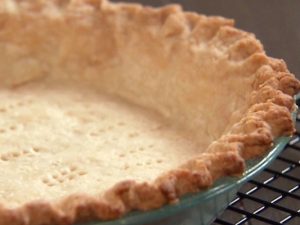Not long ago, a friend and I had dinner at
Duane’s Prime Steaks and Seafood, at the
Mission Inn in Riverside, Calif. Duane’s is a
terrific old-school steakhouse, a place where you can
get (and we did) Oysters Rockefeller, lobster mashed
potatoes, and steak with béarnaise and bordelaise
sauces. If you want a special
evening in Riverside, Duane’s is
where it’s at.
The reason I mention it,
however, is because the maitre d’
had, prior to my arrival, read one
of my Thanksgiving food columns
online.
Remember that one? The one
about the mating habits of top-heavy turkeys?
The thing about the Internet is this: You can’t
control what you’re known for.
Well. This year we’re talking about pie crust, and
we’re going to strive to maintain a G rating.
Pies have remained a holiday staple—a fixture on
the American landscape generally—despite the fact
that no one really makes them anymore.
At least, we don’t make them like we used to.
Back in those days when “lunch” was called
“dinner,” industrious homemakers churned out pies
for breakfast, dinner and supper. But the only person
getting in serious pie time these days is Mrs. Smith.
For that, I blame the crust. In the modern world,
the humble pie crust has two strikes against it.
First, it’s perceived to be high in empty calories. No
argument there.
But pie crusts are also thought to be difficult, and
that’s not necessarily true.
I grew up in a household that relied exclusively on
refrigerated Pillsbury pie crusts (a product toward
which I’m still quite nostalgic). The first time I was
confronted with making a crust from scratch was in
college, when I tackled a recipe for mocha-pecan pie.
Directions for the crust went something like this:
With your fingers, cut six tablespoons of cold butter
into one cup of flour until the mixture resembles
coarse cornmeal. Stir in ice water (about 3 tablespoons)
until the dough hangs together. Pat into
a ball, enclose in plastic wrap and refrigerate for
15 minutes. On a lightly floured surface, roll into a
10-inch circle. Transfer to your pie pan.
That’s it. I didn’t know enough to be scared, and
the crust turned out fine.
To be sure, pie crusts can be as complicated as
you’d like. The recipe I now favor for my holiday pies
calls for salted butter, unsalted butter and shortening
in exacting proportions, plus small amounts of salt
and sugar. It’s two pages long and takes six hours
from start to finish.
(And I like it. Why? Because I’m insane.)
There are also tricks for making any pie crust
better. To minimize shrinkage and maximize
flakiness, for example, use a two-step process before
baking the pie shell:
After the dough has been rolled out and laid in the
pan, let it relax in the refrigerator for 20 minutes,
then freeze it
briefly before
baking.
But the fact
is, even a basic
butter pie
crust, simply
made, is pretty
good. If you
use the
preceding
recipe , your
pie may not
win a prize at the county fair, but you probably won’t
be disappointed with it.
A few things to keep in mind: the butter should be
cold when you cut it into the flour. (You can also
combine the butter and flour in a food processor.)
Mix in as little water as possible, and don’t knead the
dough, or you’ll make it tough.
Chilling the dough makes it easier to roll out. When
you roll your dough into a circle (with a rolling pin,
naturally, though I’ve used clean wine bottles in a
pinch), use a minimum of flour; just enough to keep it
from sticking.
Follow your recipe’s instructions for pre-baking the
shell, if necessary. A Pyrex pie plate makes it easy to
see when the bottom is nice and brown.
Finally, if you want to get fancy, glaze the crust:
beat together one egg yolk and a tablespoon of heavy
cream, then brush this mixture on the crust before
baking. It will give it a beautiful golden finish that’s
every bit Blue Ribbon worthy.
[the_ad_placement id="below-menus"]
Is a memorable pie crust in your future? Find out here
- Advertisement -[the_ad_placement id="in-post"]
[the_ad_placement id="bottom-post"]


